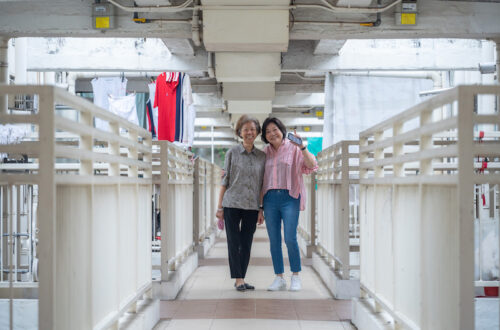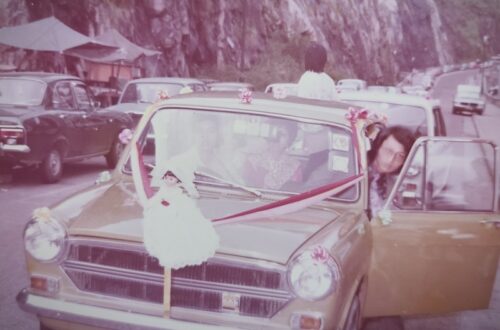Back to Childhood Memories: Sisters Support Family Livelihood by Making Plastic Flowers After School
Back to Childhood Memories:
Sisters Support Family Livelihood by Making Plastic Flowers After School
Chan King Yau and Chan King Lai / One of the first residents of Ming Wah Dai Ha

A trip down memory lane for sisters Chan King Yau (left) and Chan King Lai (right) at Ming Wah Dai Ha.
“Of course we had to help out and make some money for the family! We had to make plastic flowers at home, squatting on the floor to do it.” But why squat on the floor when you can work at a table? “The table was not for us, it was reserved exclusively for grandma’s use!” Two sisters, Chan King Lai and Chan King Yau, who are now grandmothers, recall their childhood in Ming Wah Dai Ha 60 years ago. Their recount offers essentially a snapshot of Hong Kong society in the 1960s. Back then, when kids were not playing with trading cards or hopscotching, they would find ways to help support their families. Then the most common home-based craft work was bringing home bags of materials from factories for hand processing including sewing, mending, threading and colouring.
Mom sewed clothes at home, the sisters made plastic flowers
“Wow, it’s like all these old memories are flooding back,” said Chan King Lai, who moved into Ming Wah Dai Ha in 1965 when she was in primary three. Before that, she was living with her parents, brother and grandmother in a tong lau on Mercury Street in North Point, occupying a subdivided flat that the two sisters describe as being no bigger than a shower room. “The small space was sandwiched between the kitchen on the left and the shower room on the right. It was like stepping into a pond every time I entered or left the room as I had to go through the shower room to get in and out.” With the same memories and mental images, the two sisters took turns describing the room as measuring only about 50 square feet, with “one sewing machine, a 3-foot cabinet, one table, and one bunk bed.” The first thing that came to their minds about their old home was the sewing machine, which was part of their mother’s stock-in-trade, and it remained an important production tool for the family even after their move into Ming Wah Dai Ha.
When their father was allotted a unit in Ming Wah Dai Ha, the six family members happily moved into Block C. “We were on the second floor, and the flat was a so-called ‘ground-dragging’ unit.” Ming Wah Dai Ha was built on a hillside, and the bottom of the building was shaped like a step. Although their home was on the second floor, there were no other units below the terrace, which was just above the stairs, and the residents called it “dragging the ground.” The unit was more than 100 square feet, much more spacious than the subdivided flat they had lived in before, and the corridor increased the amount of usable area even more. Outside the metal gates, they played with trading cards, marbles, and toy swords. They would also play hopscotch by drawing grids on the corridor floor with chalk taken from their teachers.
But it was not all fun and games even when school is finished and you have to return home. You got to “clock in” and make some dough. “Mom sewed clothes at home. She’d get two dozen pre-cut fabric strips from the tramways staff dormitory at a time and sew them into shirts.” There was only one sewing machine, but there were lots of other small tasks they could help with at home. The sisters would sit on the floor and make plastic flowers or paint plastic toys. Plastic toys like yellow rubber duckies? “No, but I remember an angel doll with wings!”
To grab a late-night snack at the food stalls on A Kung Ngam Road
Inarguably, painting dolls and playing hopscotch are enjoyable activities for children. According to Chan King Lai, her brother could roam the streets and play in the hills because he was a boy. Her biggest thrill then was to grab a late-night snack at the food stalls on A Kung Ngam Road every once in a while. “There were many stalls there! They served pork bone congee, cart noodles, and rice noodle rolls. After buying your meal, you would eat it while sitting on a nearby stone bench or a short stool next to the stall. I was always so happy because we were poor and couldn’t eat out often.” Chan King Lai reminisces while her sister scoffs: “How rare is that! I remember going all the time. Maybe it’s because you were the youngest and didn’t go out much!”
Chan King Lai’s sister is probably right. That Chan King Lai has such vivid memories of A Kung Ngam Road and Shau Kei Wan Main Street East before transformation gathered pace is perhaps due to the fact that she did not get out that often to see the changing cityscape. “Back then when you came down the stairs from Ming Wah Dai Ha, you would see a market building with terrazzo-tiled stalls. Main Street East used to be where boats docked, and people lived on the water. Near the tram terminus you could cross a wooden bridge to get to the shore. The street was lined with bamboo baskets full of fresh fish.” Main Street East is now a busy place with restaurants and bustling traffic. But even after all these years, the memory of this once-quiet fishing village is still vivid in the two sisters’ minds.
Chan King Lai says her mother loved buying fish here because it was fresh and cheap. Years later after her mother moved to North Point, she still came back to Shau Kei Wan often just bought the fish she used to eat when they lived in Ming Wah Dai Ha.

Chan King Yau and Chan King Lai lived in Block C for 12 years.

Revisiting the corridor, memories of shooting marbles and playing hopscotch come flooding back.

Chan King Yau got married while living in Ming Wah Dai Ha and took pictures of what the estate looked like back then.

After many years, the two sisters returned to Ming Wah Dai Ha and immediately spotted the unit they used to live in.

In the 1960s, women would also do sewing work at home to support their families.

The wedding limousine parked on A Kung Ngam Road and you could see two “cart stalls” beside the hillside.
Connection to Ming Wah Dai Ha: Moved into Block C of Ming Wah Dai Ha in 1965 and moved to Cho Yiu Chuen in 1977.
細説明華
Ming Wah Dai Ha
Documentary Project
Copyright|Disclaimer | Contact us
Organiser|Hong Kong Housing Society
Collaborator|Dragon Foundation、Lion Head Culture、Hide and Seek Tour
Copyright © 2024 Hong Kong Housing Society. All Rights Reserved.
細説明華
Ming Wah Dai Ha
Documentary Project
Copyright|Disclaimer | Contact us
Organiser|Hong Kong Housing Society
Collaborator|Dragon Foundation、Lion Head Culture、Hide and Seek Tour
Copyright © 2024 Hong Kong Housing Society. All Rights Reserved.